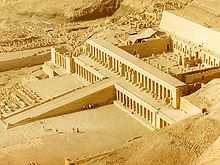Luxor massacre
| Luxor massacre | |
|---|---|
 Djeser-Djeseru (Hatshepsut’s Temple), the location of the attack | |
| Location | Deir el-Bahri, Egypt |
| Date | 17 November 1997 |
| Weapon(s) | Automatic firearms, knives |
| Deaths | 62 (not including attackers) |
| Injured (non-fatal) | > 26 |
| Suspected perpetrators | splinter group of al-Gama'a al-Islamiyya[1] |
The Luxor Massacre refers to the killing of 62 people, mostly tourists, that took place on 17 November 1997, at Deir el-Bahri, an archaeological site and major tourist attraction located across the Nile River from Luxor in Egypt.
The attack is thought to have been instigated by exiled leaders of Al-Gama'a al-Islamiyya, an Egyptian Islamist organization, attempting to undermine the July 1997 "Nonviolence Initiative", devastate the Egyptian economy[2] and provoke the government into repression that would strengthen support for anti-government forces.[3] However, the attack led to internal divisions among the militants, and resulted in the declaration of a ceasefire to suspend hostilities.[4] In mid June of 2013, the group denied that it was involved in the massacre.[5]
Location
Deir el-Bahri is one of Egypt's top tourist attractions, most notably for the spectacular mortuary temple of 18th-dynasty female pharaoh Hatshepsut, known as "Djeser-Djeseru."
The attack
In the mid-morning attack on 17 November 1997, six gunmen from the Islamic group Jihad Talaat al-Fath ("Holy War of the Vanguard of the Conquest") massacred 62 people at the attraction.[6] The six assailants were armed with automatic firearms and knives, and disguised as members of the security forces. They descended on the Temple of Hatshepsut at around 08:45. They dispatched two armed guards at the site.[6] With the tourists trapped inside the temple, the killing went on systematically for 45 minutes, during which many bodies, especially of women, were mutilated with machetes. They used both guns and butcher knives.[6] A note praising Islam was found inside one disemboweled body.[7] The dead included a five-year-old British child and four Japanese couples on their honeymoons.[8][9]
The attackers then hijacked a bus, but ran into a checkpoint of armed Egyptian tourist police and military forces. One of the terrorists was wounded in the shootout and the rest fled into the hills where their bodies were found in a cave, apparently having committed suicide together.[10]
Casualties
Four Egyptians were killed in the massacre,[11] including three police officers and a tour guide. Of the 58 foreign tourists killed, 36 were Swiss,[12] ten were Japanese, six were from the United Kingdom, four from Germany, and two were Colombians.[7] The six gunmen who perpetrated the massacre were also killed.[12]
Reaction
Following the attack, President Hosni Mubarak replaced his interior minister, General Hassan Al Alfi with General Habib al-Adly.[13]
The tourist industry – in Egypt in general and in Luxor in particular – was seriously affected by the resultant slump in visitors and remained depressed until sinking even lower with the September 11 attacks in the United States in 2001, the 2005 Sharm el-Sheikh attacks, and the 2006 Dahab bombings.[citation needed]
The massacre, however, marked a decisive drop in Islamist terrorists' fortunes in Egypt by turning Egyptian public opinion overwhelmingly against them. Spontaneous demonstrations broke out in Luxor almost immediately against the terrorists, demanding action by the government and leading to a visit by Mubarak to the region a few days later.[citation needed]
Organizers and supporters of the attack quickly realised that the strike had been a massive miscalculation and reacted with denials of involvement. The day after the attack, al-Gama'a al-Islamiyya leader Refa'i Ahmed Taha claimed the attackers intended only to take the tourists hostage, despite the evidence of the immediate and systematic nature of the slaughter. Others denied Islamist involvement completely. Sheikh Omar Abdel-Rahman blamed Israelis for the killings, and Ayman Zawahiri maintained the attack was the work of the Egyptian police.[14][15]
In June 2013 Egypt's President Mohamed Morsi appointed Adel el-Khayat as governor of Luxor. El-Khayat is a member of the political arm of al-Gama'a al-Islamiyya.[16]
See also
References
- ↑ "In free Egypt, Jihad leader says time for gun is over". Reuters UK. 18 March 2011. Retrieved 5 November 2012.
- ↑ "Fearing the worst". Al-Ahram Weekly. 5 May 2005. Retrieved 4 November 2012.
- ↑ Wright, The Looming Tower, (2006), pp.256-7
- ↑ El-Zayyat, Montasser, "The Road to al-Qaeda", 2004. tr. by Ahmed Fakry
- ↑ "Egypt's Al-Gamaa Al-Islamiya denies involvement in 1997 Luxor massacre". Egypt Independent. 19 June 2013. Retrieved 19 June 2013.
- ↑ 6.0 6.1 6.2 Napoli, James J. "Egyptian Government Continues to Blame West for Ills After Luxor Massacre". Washington Report. Retrieved 28 December 2012.
- ↑ 7.0 7.1 BBC Documentary on the Luxor Massacre, 2002
- ↑ "At Ancient Site Along the Nile, Modern Horror". New York Times. 19 November 1997. Retrieved 5 November 2012.
- ↑ "At a Swiss Airport, 36 Dead, Home From Luxor". New York Times. 20 November 1997. Retrieved 5 November 2012.
- ↑ Wright, Lawrence, The Looming Tower, (2006), p.258
- ↑ "Terror in Egypt". ADL. January 1998. Retrieved 28 December 2012.
- ↑ 12.0 12.1 "Switzerland closes inquiry into Luxor massacre". Swiss Info. 10 March 2010. Retrieved 28 December 2012.
- ↑ Rana Muhammad Taha; Hend Kortam; Nouran El Behairy (11 February 2013). "The Rise and fall of Mubarak". Daily News Egypt. Retrieved 5 March 2013.
- ↑ Wright, The Looming Tower, (2006), p.257-8
- ↑ ...Egypt tries to understand the Luxor massacre 1 December 1997 (BBC News)
- ↑ "Egypt's president appoints 17 new governors, including 8 from his Muslim Brotherhood". 17 June 2013. Retrieved 17 June 2013.
External links
- Tourists massacred at temple. 17 November 1997 (BBC News)
- Bin Laden 'behind Luxor massacre', 13 May 1999 (BBC News)
Coordinates: 25°44′18″N 32°36′23″E / 25.73833°N 32.60639°E